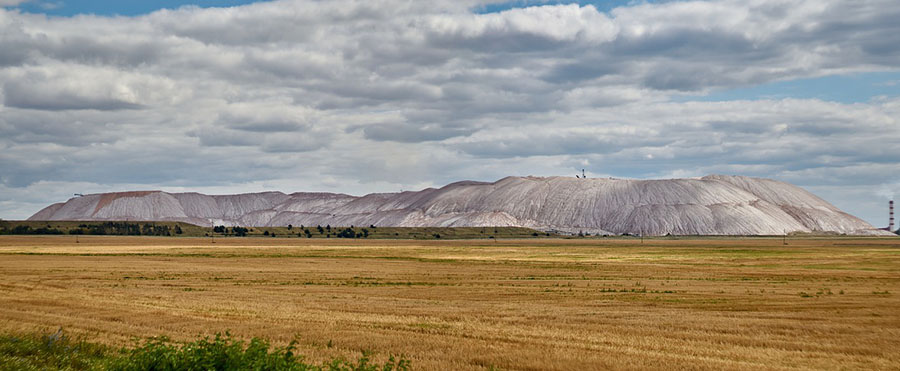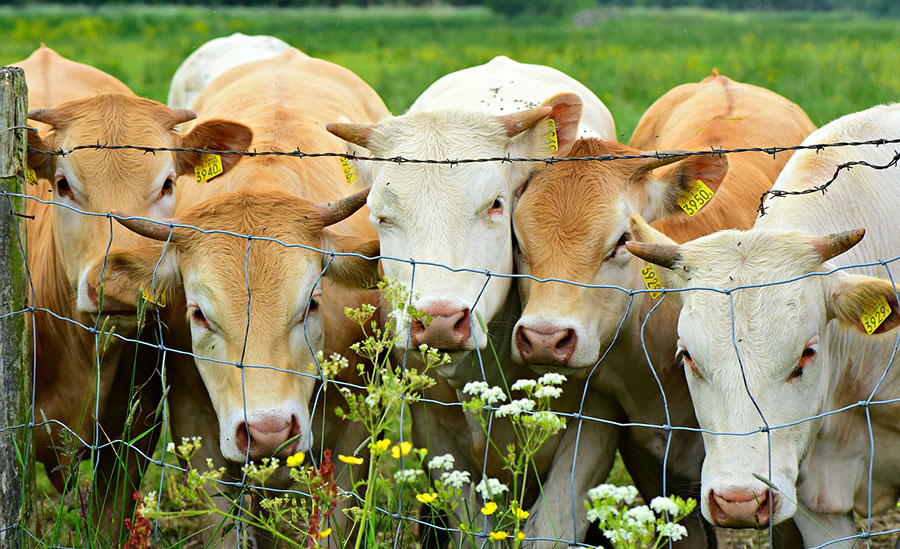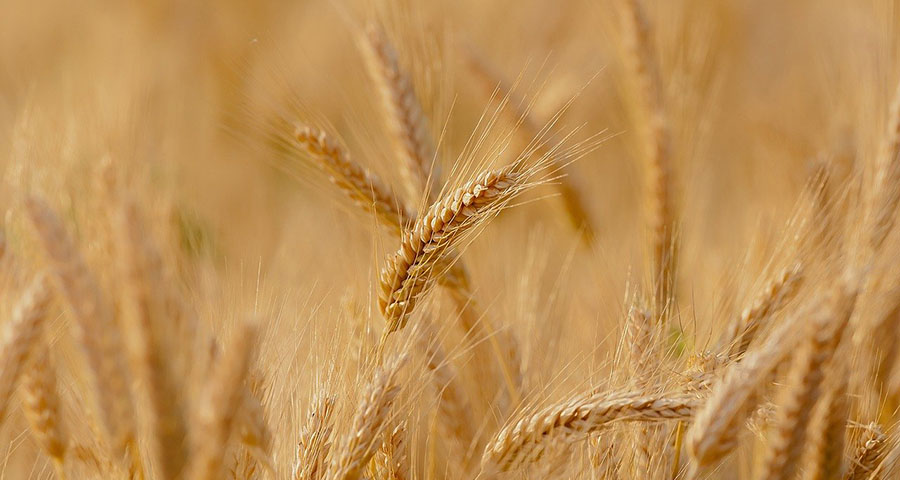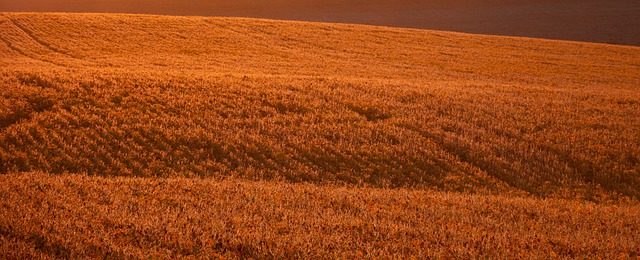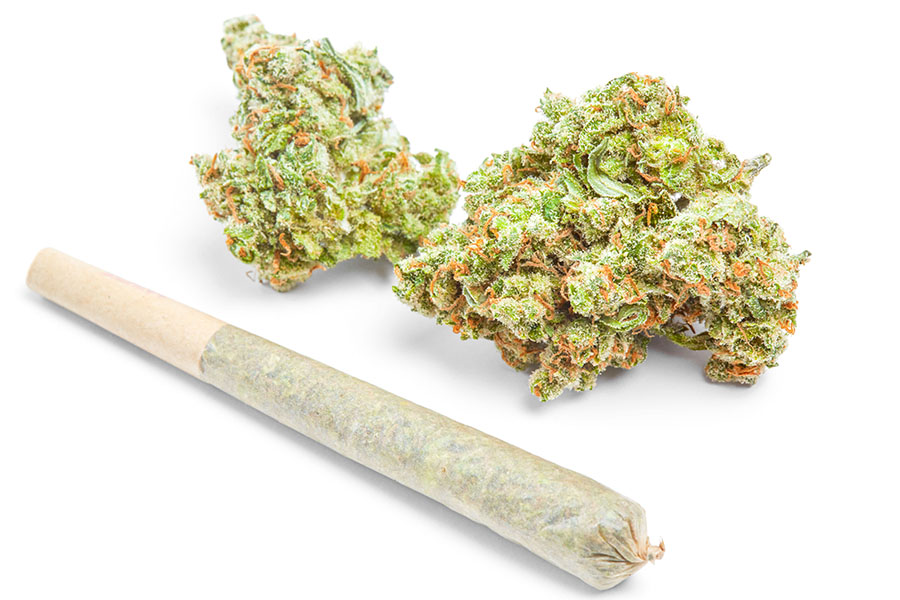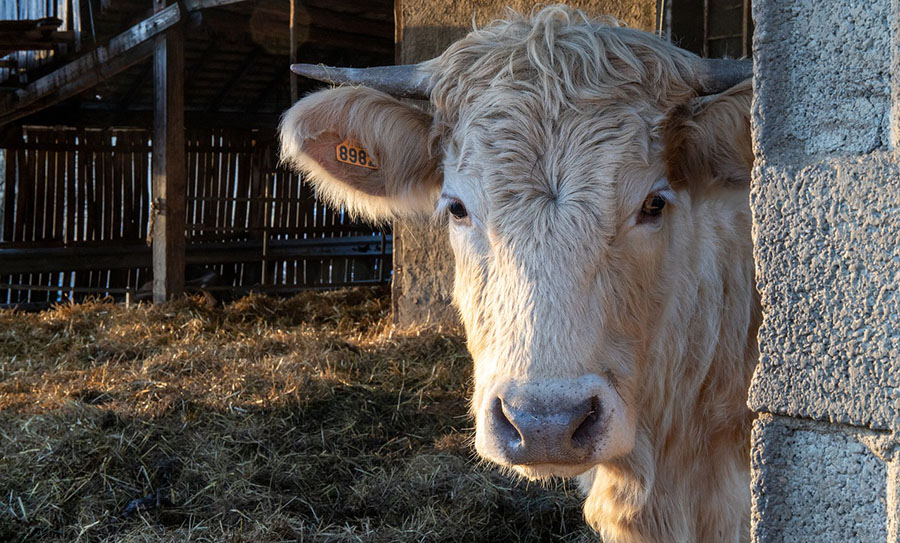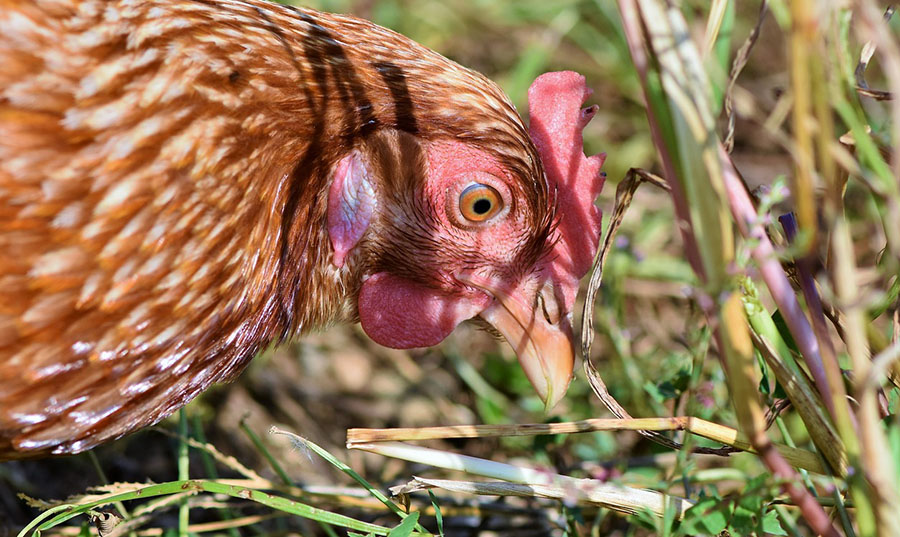The approaching storm I wrote about in last year's article The Rising Cost of Survival has certainly struck many countries with a vengeance. I thought it would be an appropriate time to revisit.
In 2008, a spike in food prices resulted in food riots around the world. The recession brought prices down while record crops allowed some stockpiles to be rebuilt and gave us a respite from the turmoil.
Unfortunately 2010 was a disaster for crops and their stockpiles. Severe droughts, record heat waves and fires combined with floods to cut crop outputs and global grain stockpiles, at the end of the 2010/11 season, were at a three-year low of 341 million tons.
By the end of 2010 the global price of food had hit a new record high—the UN's Food and Agriculture Organization's (FAO) index of 55 food commodities hit 214.7 points—the previous high was 213.5 in June 2008.
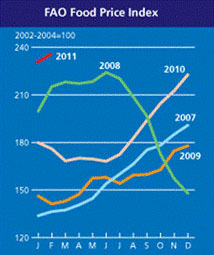
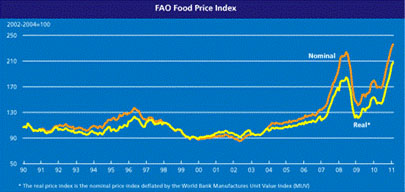
Food prices are forecast to grow by more than another 30% this year. In a worst-case situation of critical shortages, analysts, in a survey conducted by Bloomberg, say prices could skyrocket by as much as 75%.
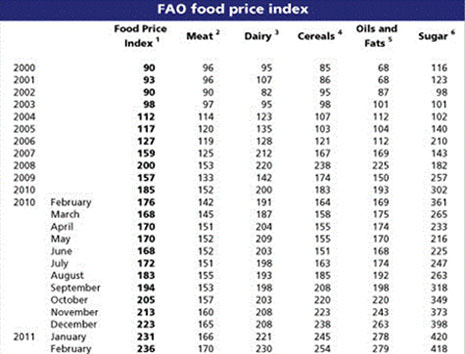
The FAO said last December that global output of all cereals (including rice, wheat and corn) will drop 1.4% to 2.23 billion tons this season, while demand will rise 1.8% to 2.26 billion tons. That will push global stockpiles 6% lower to 525 million tons, and mark the first cereal deficit since the 2008 food crisis.
"If people don't have enough to eat, they only have three options: they can revolt, they can migrate or they can die." - Josette Sheeran, executive director of the UN's World Food ProgramAlmost half of the planets population lives on less than $2.50 a day—roughly 1.4 billion people live on less than $1.25 per day. The world's extreme poor exist almost exclusively on what is a buy today, eat today plant based diet—wheat, corn or rice provide the bulk of their calories. When food prices soar these people lack the money to feed themselves and their children—when your living on a couple of dollars a day, or less, and most of your income already goes to feed your family there's no money to cover a price spike in the cost of survival.
In 2008, global food prices spiked to all-time highs and hunger riots erupted from Haiti to Morocco. In January 2011, protests and food riots began in Algeria and quickly spread. For the second time in only three years we're facing a full-blown food crisis:
- A record heat wave and growing water crisis in India
- India has an 18% annual food inflation rate
- 17 million acres of Pakistan's most fertile crop land flooded
- Drought has crippled Argentina and Bolivia
- Brazil has been hit with catastrophic floods
- Unprecedented damage to crops in Florida due to freezing weather
- Record setting rains destroyed massive numbers of crops in California
- South Korea destroyed millions of farm animals after an outbreak of foot-and-mouth disease
- A record 43.6 million Americans received food-stamp assistance in November 2010
- In the Philippines, where one out of four live on less than $1.25 a day, the government raised the retail price of rice sold from state stockpiles by 8% and will reduce the size of the countries rice inventory to about 30 days worth of consumption
- Saskatchewan, Canada—long considered one of the world's bread baskets – last year 10 million acres of wheat could not be planted because of wetness
- Bolivia cut fuel subsidies which increased gasoline prices by as much as 82%
- Six million people in North Korea are in urgent need of international aid and the country as a whole is highly vulnerable to a food crisis
- Malaysia reduced subsidies on fuel and sugar and the inflation rate rose to a 19-month high in December 2010
- Togo will stop subsidizing electricity prices and prices are expected to rise by as much as 25%
- Fresh water for irrigation and drinking is getting harder to source and more expensive
- Russia is importing grain to sustain its cattle herds until spring grazing begins
- Jordan recently increased public salaries and subsidies to counter protests over falling living standards
- The governments of Kenya, Uganda, Nigeria, Indonesia, Brazil and the Philippines have all warned of possible food shortages
- The U.S. Great Plains won't get sufficient rain to relieve dry conditions. Texas is suffering its worst drought in 44 years and the dryness stretches to Oklahoma, Colorado and Kansas
- The World Bank stated that 44 million more people have fallen into hunger due to food prices in 2010
- A return of La Nina (a cooling of the Pacific Ocean) may derail efforts by farmers to ramp up production of corn, wheat and other crops
"The power of population is indefinitely greater than the power in the earth to produce subsistence for man." -Thomas Robert MalthusMalthusian pessimism has long been criticized by doubters believing technological advancements in the following would keep crop production ahead of the population growth curve:
- Agriculture
- Energy
- Water use
- Manufacturing
- Disease control
- Fertilizers
- Information management
- Transportation
"The way humanity manages or mismanages its nature-based assets, including pollinators, will in part define our collective future in the 21st century. Human beings have fabricated the illusion that in the 21st century they have the technological prowess to be independent of nature. Bees underline the reality that we are more, not less, dependent on nature's services in a world of close to seven billion people." -Achim Steiner, UN undersecretary-general and UNEP's executive directorMany vegetables, fruits, nuts, legumes and seed crops are dependent on pollination and that service is provided mostly by bees—one of the most important global pollinators of native plants.
"The chess-board is the world; the pieces are the phenomena of the universe; the rules of the game are what we call the laws of Nature. The player on the other side is hidden from us. We know that his play is always fair, and patient. But also we know, to our cost, that he never overlooks a mistake, or makes the smallest allowance for ignorance." -Thomas Henry Huxley, biologistThe bumblebee is disappearing – bumblebee numbers are declining in Europe, Asia and North America. Honey bees are also disappearing at an alarming rate—colony loss in North America, since 2004, has resulted in fewer managed pollinators than any other time during the last 50 years.
"Sovereign nations are beginning to stockpile food to prevent unrest. You artificially stimulate much higher demand when nations start to increase stockpiles." -Jim Gerlach, A/C TradingGovernments are scrambling to lock up world supplies of grain while they can:
- Saudi Arabia's cereal imports may reach a record this year
- China is looking abroad for potentially massive quantities of wheat and corn
- Wheat purchases by Algeria, North Africa's largest importer after Egypt, climbed to 1.75 million tons in January
- Morocco, Iraq, Turkey and Lebanon issued tenders to buy wheat and/or rice
- The Mexican government is buying corn futures to avoid unmanageable tortilla price rises
- Indonesia has ordered 800,000 tons of rice, greatly exceeding their normal pace of purchases
- Bangladesh is trying to secure record grain supplies and tripled its rice import target
- Saudi Arabia plans to double its wheat inventories, the country is going to stockpile a 12-month reserve
"This is only the start of the panic buying." -Ker Chung Yang, commodities analyst at Singapore-based Phillip FuturesThe U.S. Department of Agriculture said corn stockpiles, on March 1, declined 15% from a year earlier as demand for animal feed, fuel and food climbed. In the week ended March 24, U.S. exports for delivery before Aug. 31 doubled to 1.91 million metric tons from a week earlier. Supplies held by farmers fell 26% from a year ago and represented 52% of total U.S. stockpiles, the smallest since 1973.
"Declining U.S. grain supply was a surprise, and the market is adjusting to a tightening situation. Export demand improved." -Chad Henderson, market analyst for Prime Agricultural Consultants Inc.All of this puts added pressure on prices. And there's more: Currently, there is a drought in China, which has affected 35.1% of their wheat crop. China's drought may cut the chance of rebuilding global stockpiles. China bought 116,000 metric tons from the U.S. in the week ended March 17, the most for any week since July 2005 and in China 2010 was a net importer of corn for the first time in 14 years.
In an emergency China could bid up and buy whatever they want because of the massive size of their U.S. dollar component of foreign reserve holdings.
"Because there is already much more capital available in the world than hard commodities, speculators can increase the price of consumable commodities, like foodstuffs or energy, much higher than traditional consumers and producers can react. When derivative markets are linked to commodity markets, this nearly unlimited capital from the financial sector can cause excessive price volatility." -Hedge Fund Manager Mike Masters
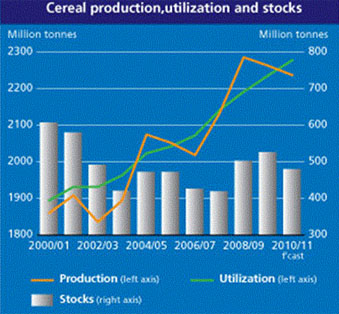
Climate Change
In 2010 the world's breadbaskets of Russia, the U.S., Australia, China, Brazil and Argentina were slammed by heat waves, flooding, droughts or freezing weather.
The worry about, and direct threat of, ongoing climate change impact on agriculture isn't about the slow almost imperceptible changes caused by a gradual shift in our weather patterns. The greatest worry is that climate change might intensify already extreme events.
And with extreme events being exacerbated by climate change an already stressed agricultural industry (by loss of arable land, shortage of fresh water for irrigation, increasing human population, staple food crops used for bio-fuel production, increasing energy costs and developing countries changing diets) is increasingly having a more difficult time feeding and clothing the world.
Many climatologists believe that the ongoing climate change the earth is undergoing will increase the frequency and severity of extreme weather events. According to insurer Munich Re, 2010 had the second highest number of natural catastrophes since 1980 and most were weather related.
Continuing climate change is a fact, unseasonable weather and permanent changes in precipitation patterns are becoming the norm rather than the exception.
Conclusion
This week wheat and soybeans are up 8% and corn hit a record high of US$7.73 a bushel.
According to the U.S. Department of Agriculture (USDA) farmers in the U.S. expect to plant one of the largest corn and soybean crops in history. Wheat production is up in China, Russia and the Ukraine—India is enjoying strong rice harvests. Growers in Brazil and Argentina have reaped bumper harvests. But production is barely keeping up with demand.
The USDA says inventories of corn and soybeans are plummeting. The supply of corn is at a 15-year low and soybean inventories are at record lows. Canola inventories are also down.
"World agricultural markets have become so finely balanced between supply and demand that local disruptions can have a major impact on the global prices of the affected commodities and then reverberate throughout the entire food chain." A recent report from HSBCLiving on the edge—U.S. grain production filled critical shortages in world supply three times in the last five years:
- 2007–2008 drought hit Australian wheat
- 2009 drought hit Argentine soybeans
- 2010 drought hit Russian wheat
"This has been a demand-driven bull market. I do not think we can see a big enough increase in U.S. acreage to rebuild inventories back to a comfortable cushion in one year. It is going to take two years of good weather and good yields. There is absolutely no room for any weather problems anywhere in the world this year." -Jim Farrell, chief executive officer of Omaha-based Farmers National Co.Good weather and good yields for two years in a row just to get back to comfortable levels?
The International Monetary Fund (IMF) said, in a recent report: "Over time, supply growth can be expected to respond to higher prices, as it has in previous decades, easing pressure on food markets, but this will take time counted in years, rather than months."
It is estimated that the population of the world reached:
- 1 billion in 1804
- 2 billion in 1927
- 3 billion in 1960
- 4 billion in 1974
- 5 billion in 1987
- 6 billion in 1999
- 7 billion projected by early 2012
- 8 billion by 2030
- ~9 billion by 2050—minimum and maximum projections range from 7.4–10.6 billion
- 11.4 billion (possible) by the mid 2060s
Already approximately 1 billion people go to bed hungry each night. Somewhere in the world someone starves to death every 3.6 seconds—most are children under the age of five.
"Rising food prices are a threat to global growth and social stability and the world is just one poor harvest away from chaos." -Robert Zoellick, president of the World BankWe have to realize that higher food prices and the resulting civil unrest are not a temporary condition but a New Normal and adjust ourselves accordingly.
Is a new normal, the coming harsh times, on your radar screen?
If not, maybe it should be.
Richard (Rick) Mills
[email protected]
www.aheadoftheherd.com
If you're interested in learning more about the junior resource market please come and visit us at www.aheadoftheherd.com. Membership is free—no credit card or personal information required.
Richard is host of www.aheadoftheherd.com and invests in the junior resource sector. His articles have been published on over 200 websites, including: The Wall Street Journal, SafeHaven, Market Oracle, USA Today, National Post, Stockhouse, Lewrockwell, Casey Research, 24hgold, Vancouver Sun, SilverBearCafe, Infomine, Huffington Post, Mineweb, 321gold, Kitco, Gold-Eagle, The Gold/Energy Reports, Calgary Herald, Resource Investor, FNArena and Financial Sense.
Legal Notice/Disclaimer
This document is not and should not be construed as an offer to sell or the solicitation of an offer to purchase or subscribe for any investment. Richard Mills has based this document on information obtained from sources he believes to be reliable but which has not been independently verified. Richard Mills makes no guarantee, representation or warranty and accepts no responsibility or liability as to its accuracy or completeness. Expressions of opinion are those of Richard Mills only and are subject to change without notice. Richard Mills assumes no warranty, liability or guarantee for the current relevance, correctness or completeness of any information provided within this Report and will not be held liable for the consequence of reliance upon any opinion or statement contained herein or any omission.
Furthermore, I, Richard Mills, assume no liability for any direct or indirect loss or damage or, in particular, for lost profit, which you may incur as a result of the use and existence of the information provided within this Report.
Richard Mills does not own shares of any companies mentioned in this report



